Good Slot Car Rules make for good slot car racing.
For 10 years, Nomad Raceways held weekly club races (often 3 or more per week) on a variety of tracks for a wide variety of cars. We had 12 classes of cars and about half of our classes permitted traction magnets. We attribute the health and variety of our racing program in large part to good clear rules. The cornerstone of our rules for traction magnet classes is what we call the “One Gee” (1 gravity) rule.
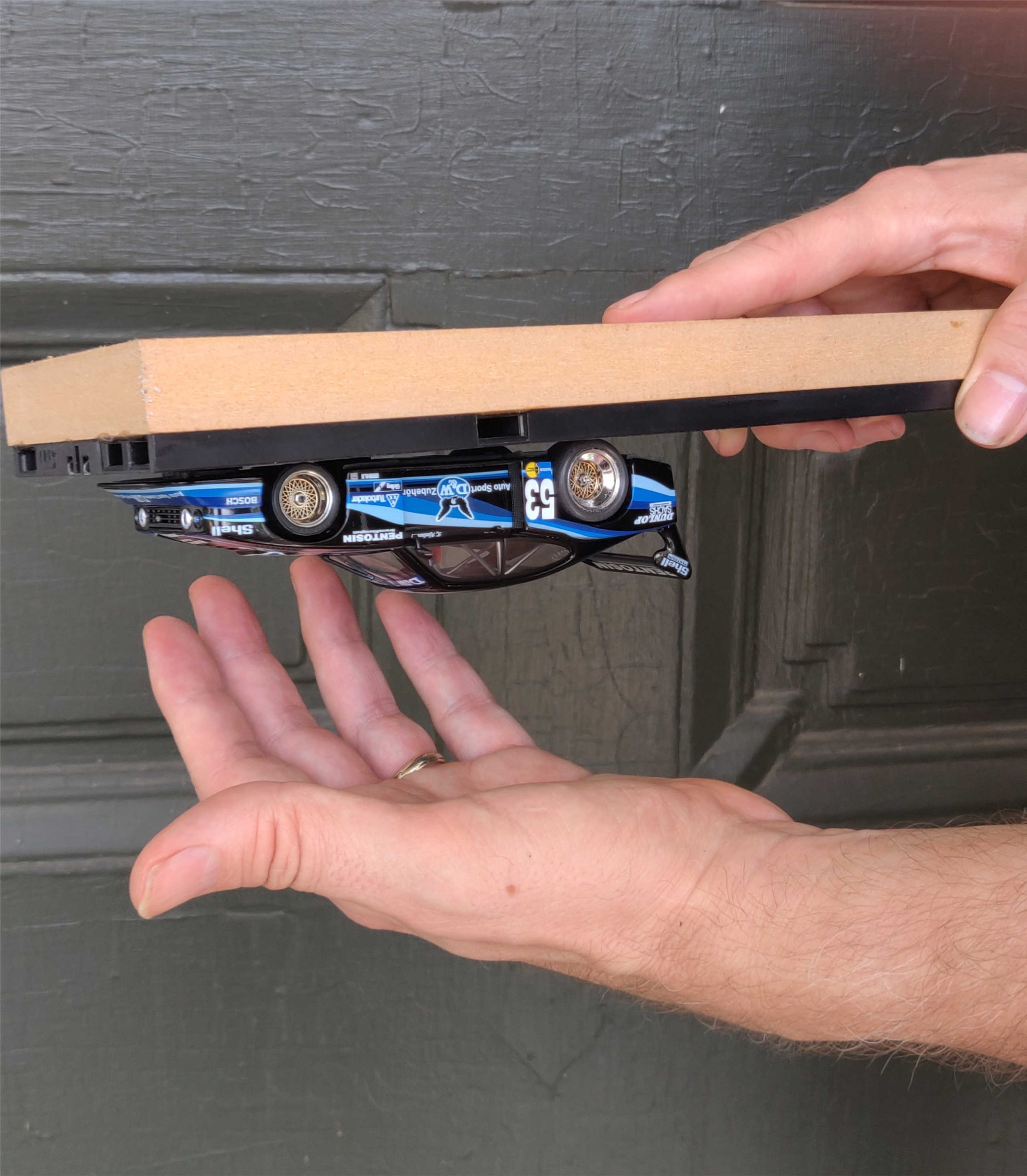
This simple slot car rule accomplishes several things at once:
- The One G slot car rules provide a clear, easily tested limit on the biggest factor in magnet car performance. It’s quick and eliminates debate over picky rules. Racers can check their own car for conformance and adjust them without special equipment.
- By equalizing the ratio of magnet to weight, a wide variety of cars can be included. This rule is superior to use of scales that measure magnet downforce because it takes into consideration magnet placement. Fore and aft position of the magnet has a strong influence on car performance.
- “One G” Slot Car Rules open up the field variety letting people run what they like. We routinely have close races with, for example; GT cars from Scalextric, Carrera, Fly and ScaleAuto with similar lap times. Without the One Gee Rule, often the only competitive cars are a single brand; sometimes even a single model.
- A common problem with magnet racing is “escalation”. If adding magnets to the cars is permitted without limiting slot car rules, racers will invariably add more and more magnet in search of maximum speed. This leads to cars only capable of very short races due to motor overheating. At some point, there is very little driving left to do as the cars negotiate most of the track at full throttle. When cornering limits are exceeded, there is no drift or warning, the car snaps off the track in a violent crash and car damage is common. We find that interest in this racing style tends to be very short lived and has lead to the dissolution of many slot racing clubs. “One Gee” caps traction at a reasonable level and has worked very well for us for many years.
- Specifying “box stock” is not a good substitute for good Slot Car Rules . We have found a considerable variation in magnetic downforce in a single shipment of new, “identical” cars. Manufacturing tolerances are such that some “box stock” cars will always be better than others. Being racers, there is also a chance of stronger magnet substitutions or hidden magnets added above the stock ones could affect performance as well. Since magnetic downforce is the biggest and most important variable, we use this rule to equalize it with a simple, quick test.
- Use of the “One G Rule” eliminates the need for most other rules that attempt to control performance though measurement or component specification. Motors also vary in performance, but if the magnetic downforce is limited, and the track does not have long straights, the advantage of a faster motor is less. With long straights motor rules may also be needed…
Here’s how “One G” Slot Car Rules work:
Select a piece of standard straight of the same type as your racetrack. Cut a piece of ¾” MDF, Corian or similar that is flat and stable. Use hot glue, contact cement or epoxy or double sided adhesive tape to secure the track MDF base. Clamp or apply weight until track is bonded to base. The purpose of bonding plastic track to a base, is to insure that this test section is and will remain flat. Each raceway will have one “official test track”. You can make up duplicates for racers to test on, but because there can be slight variations in rail height, check each new test track to confirm you get the same results at the “official” one. Bonded tracks that “test” the same as the Official one should be marked as “Official”, those that do not may be used for ride height set up or tire sanding only.
There are differences in the amount of magnetic attraction between track brands. Carrera’s 1/24 track is a mild stainless that contains less iron, so magnet tuning on a Carrera Track would give too much downforce on Ninco, SCX or Scalextric track… Make your test track from whatever brand of track you are racing on.
Prior to the race, all cars must pass this test: Place the car on the test track, with its front even with the end of the track or a line marked on track. Place all cars in the same way in case there is any variation over the track length. Slowly turn the track section over, pivoting the track at the slot centerline to avoid any momentum which might “help” the car off the track. Legal cars will fall off the track to your other hand. (Don’t drop them!) Cars that have too much magnet will hang upside down.
Cars that “hang” must have their traction magnet reduced or have weight added. In most cases, adding adhesive-backed weight to the front of the chassis will do the trick. Sometimes it is best to palace thin plastic or paper spacers to elevate the magnet away from the rails or change to a thinner or weaker magnet. Sometimes going to slightly larger diameter tires can be a good solution. We use very thin adhesive backed lead tape and small 1/32” thick neodymium magnets that can be added singley or in layers until the optimum setting is achieved.
A car which has been tuned for optimum performance under this rule will often be so close to the limit that it may take a second or more before it “decides” to fall!
No adjustment that affects One G Slot Car Rule test may occur during race. For that reason, cars not on track are kept in “Parq Forme” a holding area so that they cannot be “accidentally adjusted” post test. If racing is becoming serious or if other are prizes involved, it is a good idea to announce and have a post race “One G” test prior to confirming a winner. Failing the post race test results in disqualification.
Here are tips for how to tune your cars for the One G Slot Car Rules :
In stock form on Carrera track, we find most cars can have a little added magnet. Others may need magnet reduction or weight added. The placement of the magnet is as important as its strength. For best lap times the best place for traction magnets just in front of the rear axle. The downside to this is that the front may be too light on a track with significant elevation change or with high powered cars. Rearward magnet positions allow for very little drift. When the cornering limit is exceeded, the car may de-slot without warning. Placing the magnet slightly forward reduces the tendency for the magnet to release suddenly as the car drifts because the magnet stays over the rails at greater drift angles. A more forward magnet position makes the car “more forgiving” and more likely to recover from a drift and thereby less likely to crash. Choosing the benefit of less crashes with a more forgiving car vs. more speed from a less predictable car is up to the driver.
Many plastic chassis cars have bars under the motor. Clipping them away gives a recessed pocket for magnets. Magnets will hold directly to motor can. For sidewinder cars and some in-lines, we often remove plastic, (if any) under the motor and stick the traction magnets to the motor casing on their own power. We have not seen any effect on motor performance from doing this. This is very convenient for testing different magnet combinations and sometimes allows the magnets to be easily removed for subsequent no-traction-magnet races. With smaller magnets or when attaching them to chassis, it is often necessary to use a small drop of cyanoacrylate (super) glue to keep the magnets in place. To remove the magnets, use a small amount of acetone or super glue remover to release them.
Be careful to allow clearance so that magnets do not touch the rails and cause a short. For some low-slung cars, magnets must only be placed inside the chassis. Plastic has no effect on magnetic fields. Magnetic attraction climbs dramatically with proximity, so the higher the magnet is in the car the stronger it must be. Stacking magnets on top of each other greatly increases their strength. If you are running contemporary Carrera cars with two traction magnets, you may have to remove the central magnet or move spacers to pass this test. If running exclusively similar Carrera 1/32 or 1/24 cars we generally forgo this rule and run them with the REAR magnets removed. We find these cars are fun and much more “forgiving” on center magnets only but this setup is not competitive with cars set to the limit of One G rule.
For cars that “hang” and fail; the “One G” Slot Car Rules test, it is often best to add weight near the front of the car to get it to “drop”. for some cars, especially short wheelbase sidewinders the weight improves handling as well. We like thin lead tape for weight. It is easily applied and cut with a knife to any shape. If there is clearance under the car so that it cannot contact the track or rails, we allow it on the underside of the car for easier set up.
At Nomad, we stock a wide variety of magnets and lead tape for One G Slot Car Rules magnet tuning. The most useful magnets are small 1/32” thick neodymium magnets because they can be added until just the right balance is found. Magnet tuning supplies are available from Jim@NomadRaceways.com and you can even send your cars in for tuning by our experts.
Examples:
There are many configurations that work! Drivers often have preferences. Some like the magnets set wide, to increase as the car drifts and “catch” the car, some like the magnets directly over the rails to prevent drift as magnets pull car back to center. Others like the forgiving nature of magnets placed further forward… Some like cars heavy with more lead and more magnet, or light… Dips and banked turns will also affect optimal placement.
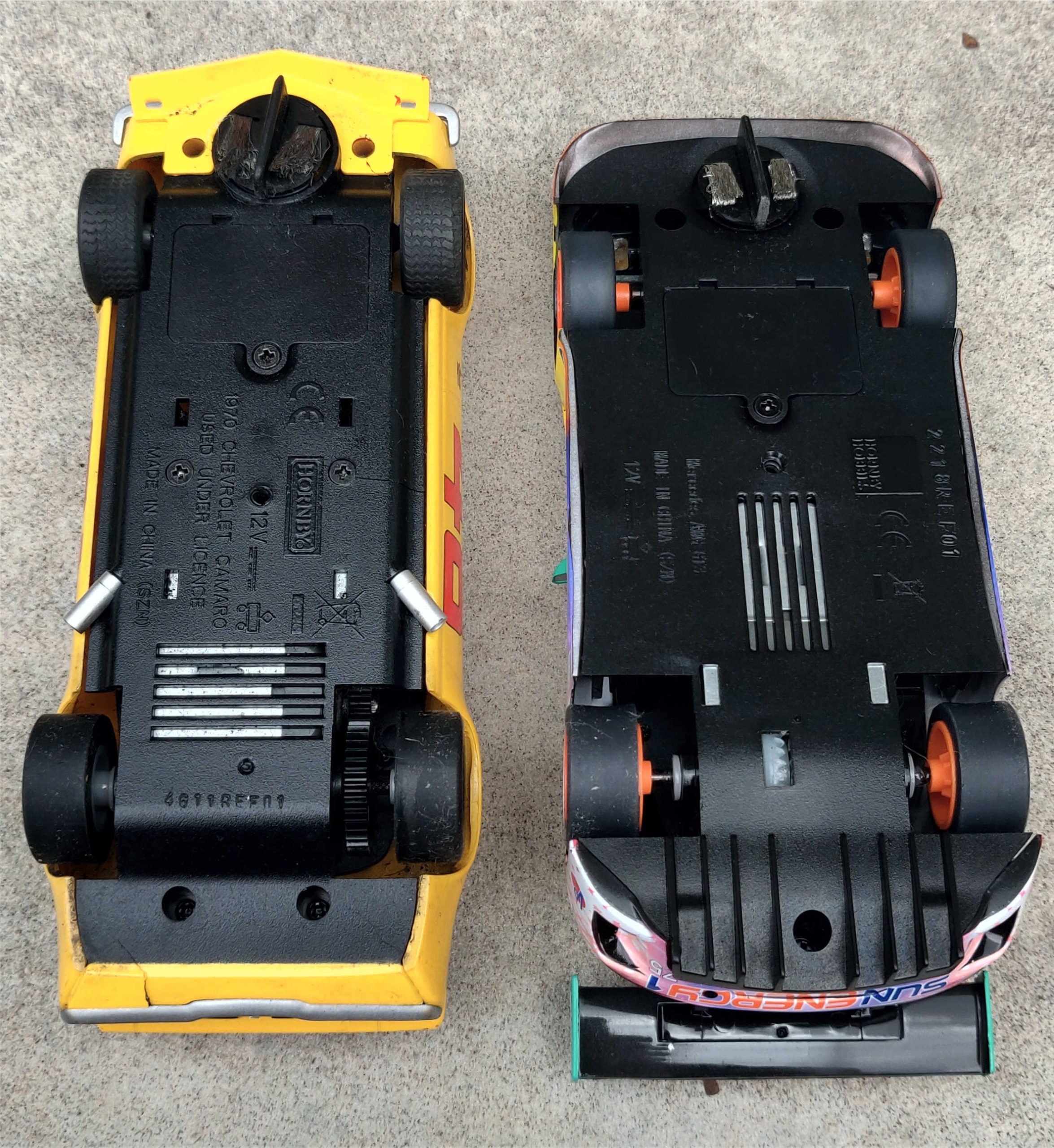 Before motor bar removal.
Before motor bar removal.
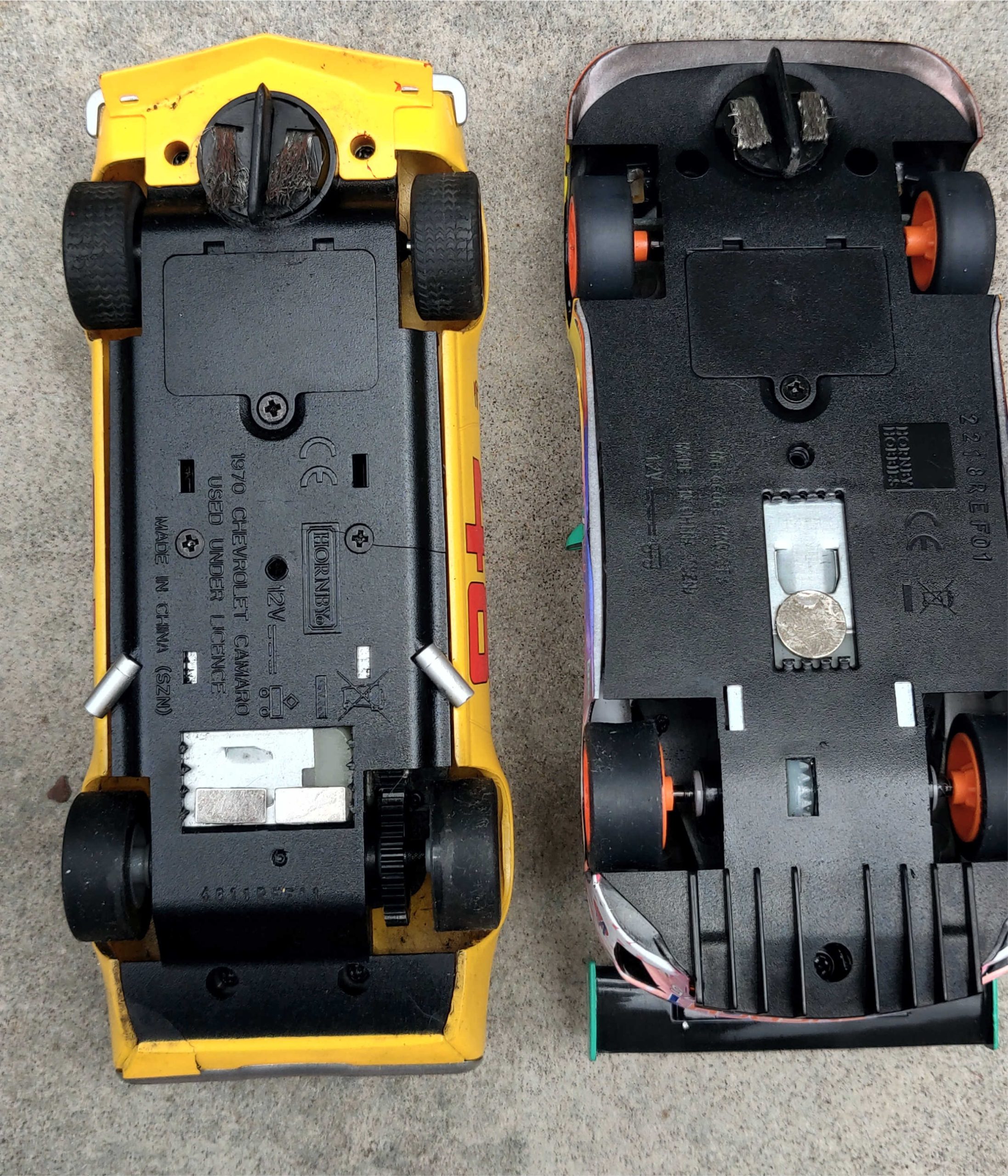 After One Gee magnet set up.
After One Gee magnet set up.
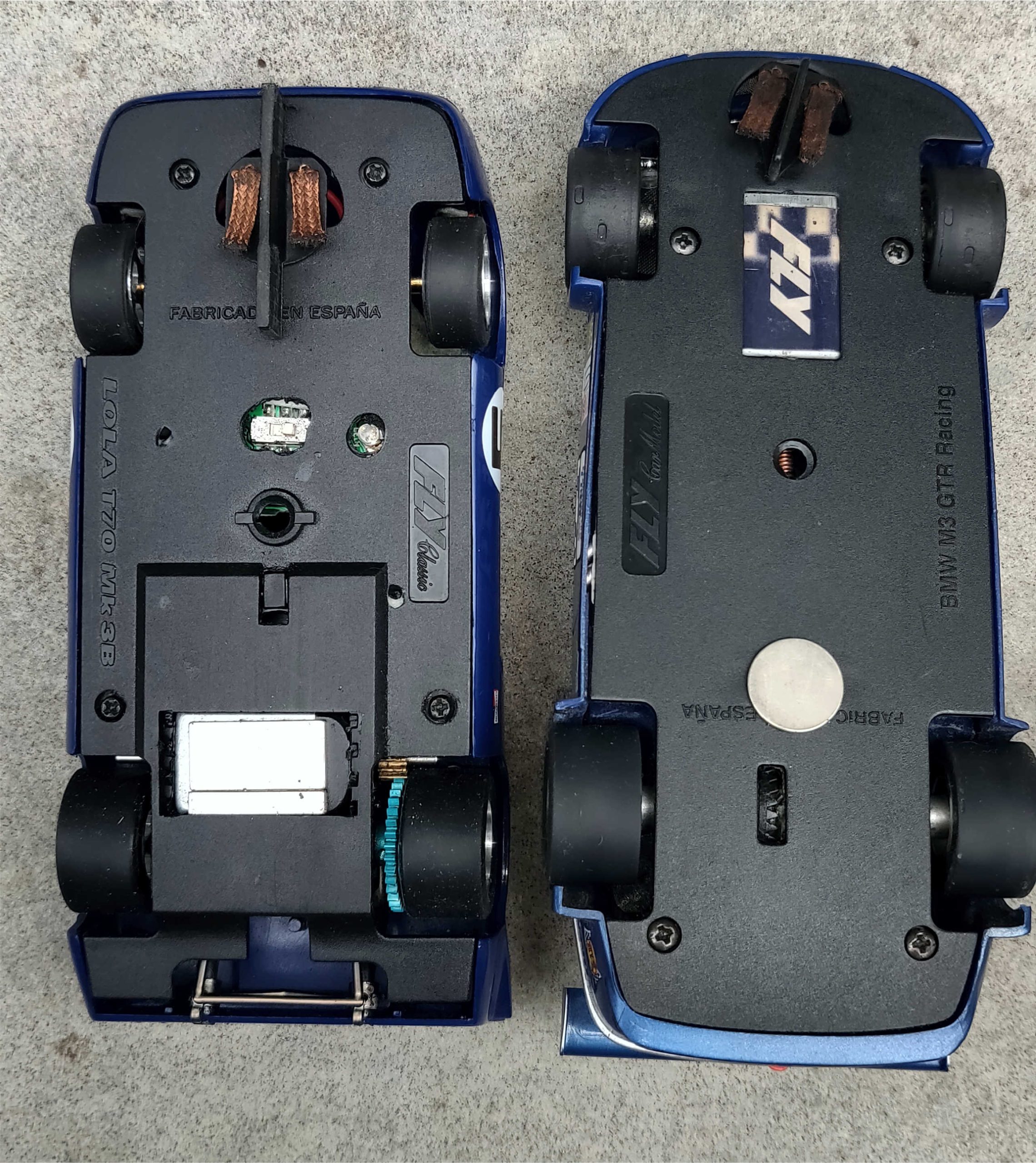 Best set-up for the Fly car above is to remove the existing magnet well ahead of the motor and add 1/32” thick magnets on the motor. The car also has a Carrera Digital Chip added. The car on the right is a front motor car with a strong magnet inside the chassis. adding a 1/32” thick magnet increases the effect to One Gee standard. A drop of glue keep the magnet from shifting. This car has adequate clearance the magnet will not touch. If that were not so, substantially more magnet would have to be added inside the chassis for the same effect.
Best set-up for the Fly car above is to remove the existing magnet well ahead of the motor and add 1/32” thick magnets on the motor. The car also has a Carrera Digital Chip added. The car on the right is a front motor car with a strong magnet inside the chassis. adding a 1/32” thick magnet increases the effect to One Gee standard. A drop of glue keep the magnet from shifting. This car has adequate clearance the magnet will not touch. If that were not so, substantially more magnet would have to be added inside the chassis for the same effect.
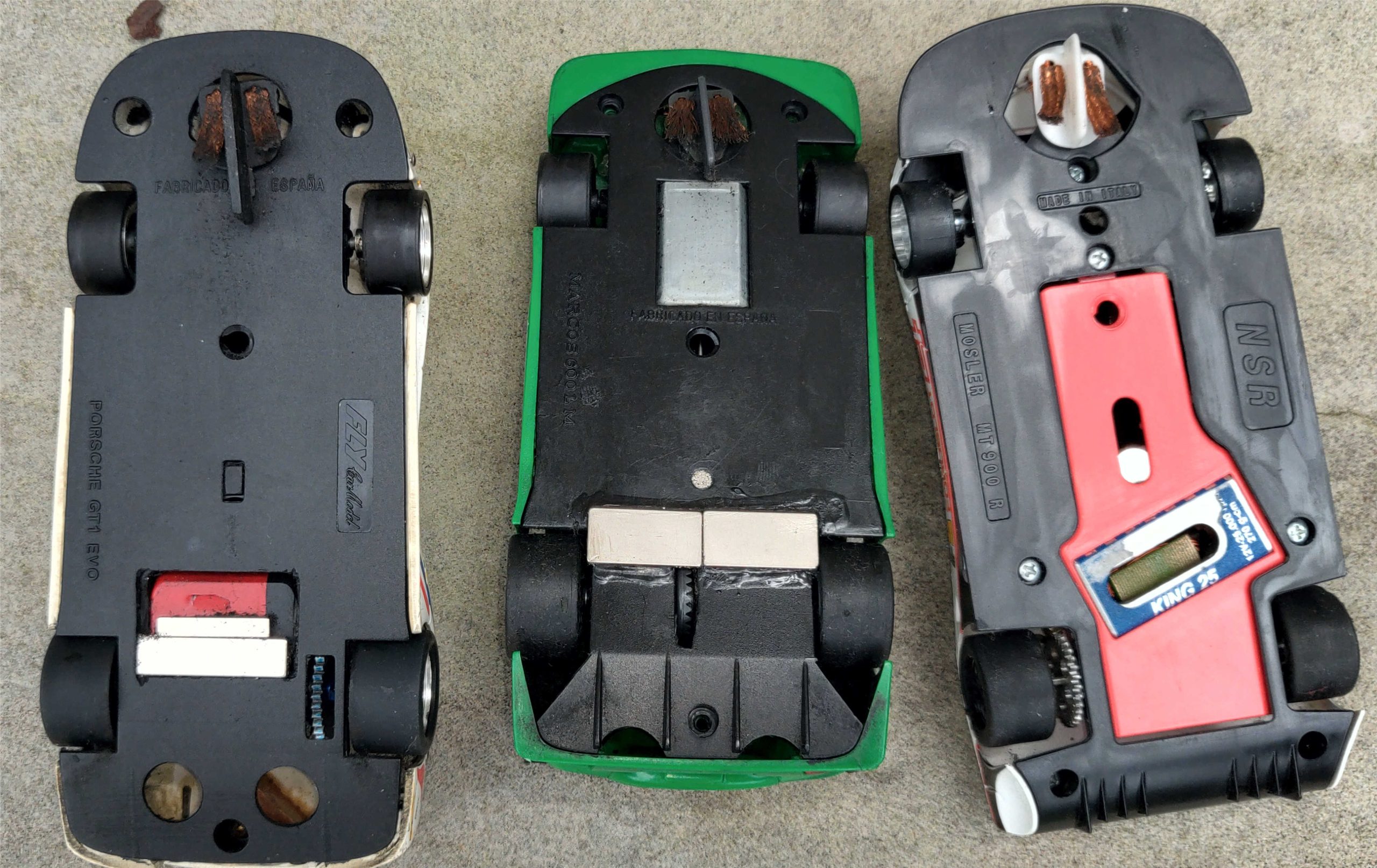 Two more Fly cars with One Gee set up. The NSR car at right has only it’s stock magnet but it’s motor also has some traction magnet effect. This car had too much magnet in stock form, as the chassis was bowed down in the middle increasing magnet effect. The car would touch the track and it can be seen that the label on the motor is partly worn off as a result. Heating the chassis in hot water, pressing it flat and allowing it to cool stopped the dragging and also made the car One G legal.
Two more Fly cars with One Gee set up. The NSR car at right has only it’s stock magnet but it’s motor also has some traction magnet effect. This car had too much magnet in stock form, as the chassis was bowed down in the middle increasing magnet effect. The car would touch the track and it can be seen that the label on the motor is partly worn off as a result. Heating the chassis in hot water, pressing it flat and allowing it to cool stopped the dragging and also made the car One G legal.
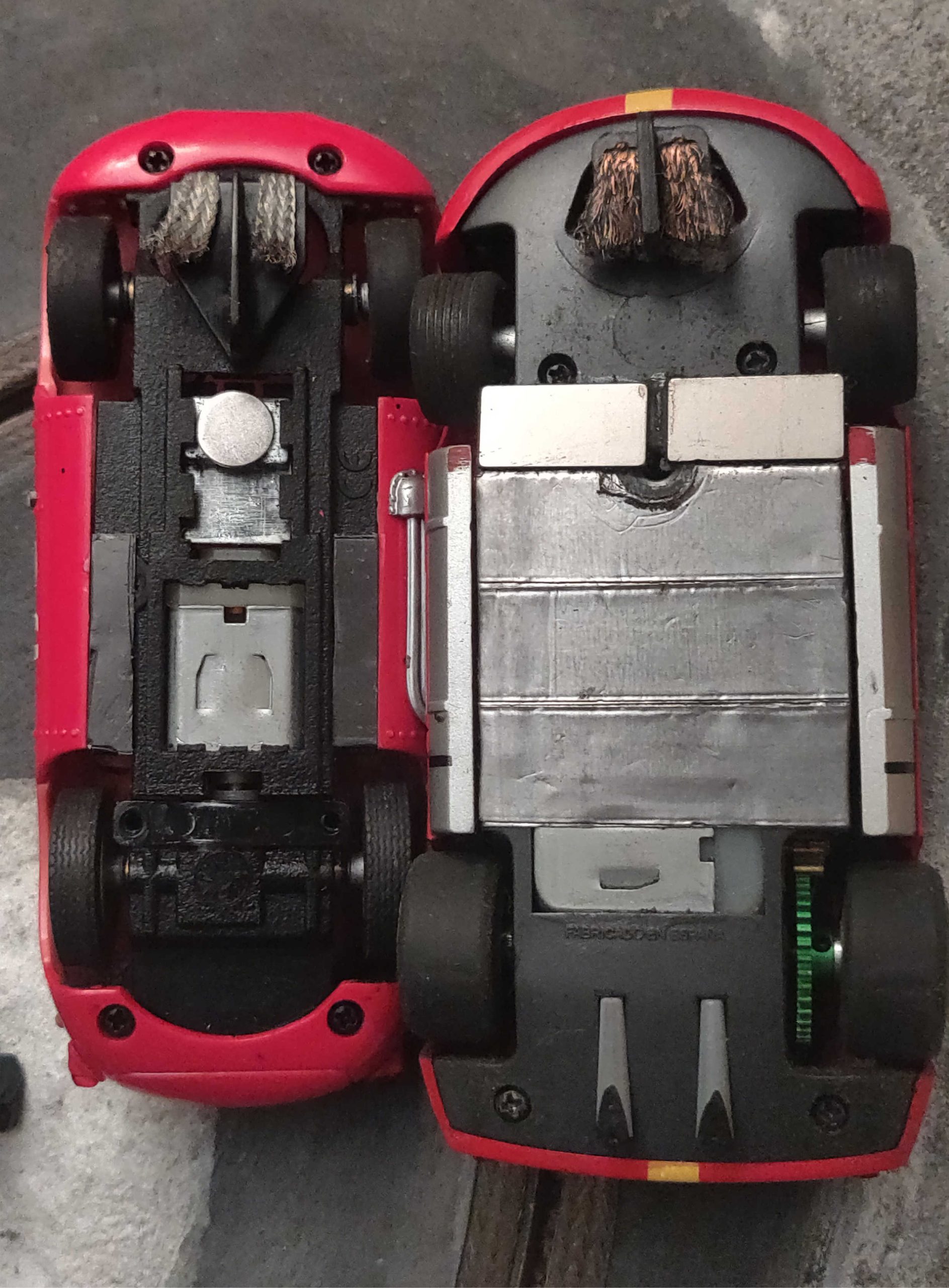 We have added a variation to our rules for our Vintage Sports Car classes. We thought that vintage sports cars should drift in the turns and be slower than modern cars. Our normal rule made the cars too aggressive. On the other hand, it took too much tuning and modification to get some of the cars to be competitive with no traction magnets. So, we made a variation of the rule; for Sports Car Classes, no traction magnet may be placed further than 1.5” from the front of the guide blade. This creates a class midway between magnet and no magnet cars. They drift and slide that way an early sports car should!
We have added a variation to our rules for our Vintage Sports Car classes. We thought that vintage sports cars should drift in the turns and be slower than modern cars. Our normal rule made the cars too aggressive. On the other hand, it took too much tuning and modification to get some of the cars to be competitive with no traction magnets. So, we made a variation of the rule; for Sports Car Classes, no traction magnet may be placed further than 1.5” from the front of the guide blade. This creates a class midway between magnet and no magnet cars. They drift and slide that way an early sports car should!
The car on the left is in “Early Sports” restricted to .25″ wide with and 2.2″ track width. It is light and narrow. Car with wider tires and track run a “Late Sports” as is the heavy and wide Porsche here. Both cars are quick yet drifty and fun to drive. A racers tip: with this set up it is best to have independent rotating front wheels or low friction front tires. IF your racers feel the standard One G rule is too aggressive, try this variation in other classes!
I hope use of our One Gee rule helps your racing program prosper.
Race on!
Here is a video of One G testing
~ Jim Cunningham Founder of:
